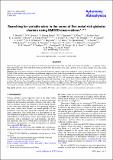Searching for variable stars in the cores of five metal-rich globular clusters using EMCCD observations
View/
Date
01/2015Author
Funder
Grant ID
UF100010 / UF130581
PP/F000065/1
ST/M001296/1
Keywords
Metadata
Show full item recordAbstract
Aims. In this paper, we present the analysis of time-series observations from 2013 and 2014 of five metal-rich ([Fe/H] > −1) globular clusters: NGC 6388, NGC 6441, NGC 6528, NGC 6638, and NGC 6652. The data have been used to perform a census of the variable stars in the central parts of these clusters. Methods. The observations were made with the electron-multiplying charge-couple device (EMCCD) camera at the Danish 1.54 m Telescope at La Silla, Chile, and they were analysed using difference image analysis to obtain high-precision light curves of the variable stars. Results. It was possible to identify and classify all of the previously known or suspected variable stars in the central regions of the five clusters. Furthermore, we were able to identify and, in most cases, classify 48, 49, 7, 8, and 2 previously unknown variables in NGC 6388, NGC 6441, NGC 6528, NGC 6638, and NGC 6652, respectively. Especially interesting is the case of NGC 6441, for which the variable star population of about 150 stars has been thoroughly examined by previous studies, including a Hubble Space Telescope study. In this paper we are able to present 49 new variable stars for this cluster, of which one (possibly two) are RR Lyrae stars, two are W Virginis stars, and the rest are long-period semi-regular or irregular variables on the red giant branch. We have also detected the first double-mode RR Lyrae in the cluster.
Citation
Skottfelt , J , Bramich , D M , Figuera Jaimes , R , Jørgensen , U G , Kains , N , Arellano Ferro , A , Alsubai , K A , Bozza , V , Calchi Novati , S , Ciceri , S , D'Ago , G , Dominik , M , Galianni , P , Gu , S-H , Harpsøe , K B W , Haugbølle , T , Hinse , T C , Hundertmark , M , Juncher , D , Korhonen , H , Liebig , C , Mancini , L , Popovas , A , Rabus , M , Rahvar , S , Scarpetta , G , Schmidt , R W , Snodgrass , C , Southworth , J , Starkey , D , Street , R A , Surdej , J , Wang , X-B & Wertz (The Mindstep Consortium) , O 2015 , ' Searching for variable stars in the cores of five metal-rich globular clusters using EMCCD observations ' , Astronomy & Astrophysics , vol. 573 . https://doi.org/10.1051/0004-6361/201424967
Publication
Astronomy & Astrophysics
Status
Peer reviewed
ISSN
0004-6361Type
Journal article
Description
D.M.B. and K.A.A. acknowledge support from NPRP grant # X-019-1-006 from the Qatar National Research Fund (a member of Qatar Foundation). A.A.F. acknowledges the support from DGAPA-UNAM grant through project IN104612. K.A.A., C.L., M.D., K.H. and M.H. acknowledge grant NPRP-09-476-1-78 from the Qatar National Research Fund (a member of Qatar Foundation). CS has received funding from the European Union Seventh Framework Programme (FP7/2007-2013) under grant agreement No. 268421. S.H.G. and X.B.W. would like to thank the financial support from National Natural Science Foundation of China through grants Nos. 10373023, 10773027 and 11333006. T.H. is supported by a Sapere Aude Starting Grant from The Danish Council for Independent Research. T.C.H. acknowledges support from the Korea Research Council of Fundamental Science & Technology (KRCF) via the KRCF Young Scientist Research Fellowship Programme and for financial support from KASI travel grant number 2013-9-400-00. H.K. acknowledges the support from the European Commission under the Marie Curie IEF Programme in FP7. M.R. acknowledges support from FONDECYT postdoctoral fellowship No. 3120097. O.W. (FNRS research fellow) and J. Surdej acknowledge support from the Communauté francaise de Belgique - Actions de recherche concertées – Académie Wallonie-Europe. Date of Acceptance: 31/10/2014Collections
Items in the St Andrews Research Repository are protected by copyright, with all rights reserved, unless otherwise indicated.

